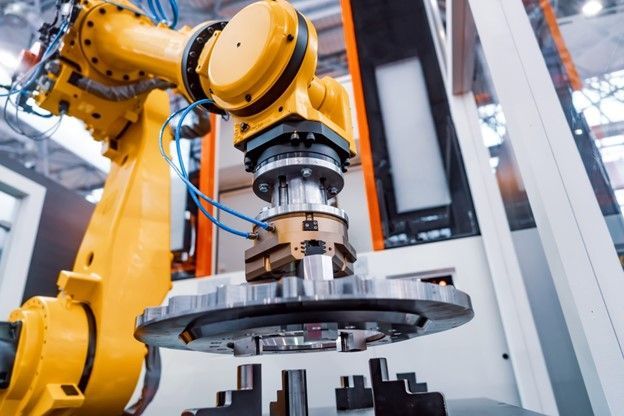How Robotics and Automation Drive Higher Efficiency in Manufacturing
Manufacturing has come a long way from manual assembly and repetitive labour. Now, robotics and automation are transforming production floors into more innovative, faster, and safer environments.
With technology handling everything from precision welding to real-time quality inspections, manufacturers are rethinking how work gets done.
Keep reading to learn how manufacturers use robotics and automation to address labour shortages, reduce production costs, improve quality, and seamlessly scale operations — even in the face of changing demand.

The Evolution of Robotics in Manufacturing
Robotics in manufacturing started as single-function machines decades ago and has evolved into sophisticated systems capable of adapting, learning, and collaborating.
Historical Milestones
The first industrial robots emerged in the 1960s, mostly performing die casting and spot welding in the automotive industry. By the 1980s, programmable robotic arms were standard on automated assembly lines.
Today’s advanced systems include collaborative robots (cobots) that work safely side-by-side with human operators, helping with assembly, machine tending, or precision handling.
At the same time, fully autonomous robots can now navigate factory floors independently, managing complex logistics like material transport, inventory movement, and even real-time coordination with other machines.
Market Growth
The International Federation of Robotics says global adoption is surging. More than 553,000 industrial robots were deployed worldwide in 2022, which is a record high. Investment in robotics and automation in manufacturing continues to grow, with industries responding to labour shortages, rising wage pressures, and the need for scalable, efficient production.
Scope of Automation
Automation extends beyond assembly alone. Manufacturers use robotics for material handling, packaging, quality inspection, palletizing, and even warehouse parts distribution.
These systems can expand and allow more flexible responses to demand changes and product variations.
Types of Robotic Systems and Their Applications
Robots in manufacturing come in many forms, each designed with a specific task in mind. From assembling parts to welding, packaging, or quality inspection, these machines handle repetitive, high-precision work that boosts efficiency and consistency on the production floor.
Articulated Robots
These robotic arms have multiple joints for welding, assembly, and painting. They provide extensive flexibility in movement and are often used in automated assembly lines where operators require high precision and speed.
SCARA Robots
Selective Compliance Articulated Robot Arms (SCARA) are valid for high-speed, precision tasks like pick-and-place, sorting, and small-part assembly. Their small footprint makes them popular for electronics and consumer goods production.
Collaborative Robots
Cobots in production have become more common, especially in small to mid-sized operations. They’re designed to work safely next to humans, assisting with tasks like packaging, fastening, or inspection without fencing or heavy-duty safety barriers.
Autonomous Mobile Robots (AMRs)
These robots move freely throughout a facility, transporting raw materials or finished goods. AMRs rely on sensors, cameras, and AI to safely navigate obstacles and people, making them a strong alternative to traditional conveyor systems or forklifts.
Vision-Guided Robotics
By integrating machine vision, these robots can identify and sort products, detect defects, and ensure proper placement. They’re critical for quality control, inspection, and ensuring consistency in final output.
Benefits of Embracing Robotics and Automation
Adopting automation is a competitive edge and is becoming necessary for long-term operational success.
Increased Productivity and Efficiency
Robotic systems don’t take breaks. They operate 24/7, keeping production lines moving at a consistent pace. For manufacturers focused on enhancing productivity with robotics, quicker cycles and reduced downtime make it easier to meet deadlines and raise output without stretching resources.
Consistent Quality
Manual errors are common in repetitive tasks, but robots always follow the same process. That repeatability means fewer defects, lower rejection rates, and a product that meets exact specifications.
Enhanced Worker Safety
Robots reduce workplace injuries by automating hazardous or physically demanding tasks, such as welding, heavy lifting, or working with toxic substances. This strategy allows employees to shift into roles focused on supervision, quality control, or maintenance, improving morale and retention.
Cost Savings
While the upfront price can be significant, the industrial robots' ROI speaks for itself. Lower labour costs, reduced waste, fewer injuries, and faster output mean most companies see a return within two to three years, especially in high-volume production environments.
Implementation Considerations
Not every process needs a robot. Successful automation begins with strategic planning and knowing where technology adds the most value.
Assessment
Evaluate which processes are repetitive, time-consuming, or prone to errors. Tasks involving manual inspection, part sorting, or packaging are typically good starting points. Automation isn’t about eliminating jobs but shifting human expertise to more impactful and strategic roles.
Investment and ROI Analysis
Understand your total cost of ownership, including hardware, integration, training, and ongoing maintenance. Then compare that to labour savings, increased output, and improved quality. For many operations, robotics and automation in manufacturing have become more cost-effective than continued hiring or overtime expenses.
Workforce Implications
Automation changes how people work. Successful transitions require reskilling and training. Employees might move into roles like robot operation, programming, or maintenance, often earning higher wages and following new career paths.
System Integration
Integration requires careful planning to avoid bottlenecks. Modern robotic systems connect with existing machines, sensors, and software. Choose vendors or partners who understand your environment and can support data exchange between systems.
Overcoming Challenges
Even with all the advantages, automation has its hurdles. However, with proper planning, you can anticipate and solve most challenges.
Technical Barriers
Not every factory is plug-and-play. Some workflows require custom-built solutions or significant retrofitting. It’s worth working with automation consultants to set up your factory to meet your current needs and long-term goals.
Maintenance and Upkeep
Like any equipment, robots require regular maintenance. Predictive maintenance, powered by sensors and data analytics, can help detect early signs of wear, minimizing downtime and extending equipment life.
Scalability
As business grows, so should your automation. Choose modular systems that allow for easy upgrades, expansions, or software integrations, especially as your operation scales or your product line evolves.
Real-World Success Stories
Many manufacturers are already realizing the benefits of automation, often in measurable ways:
- KOYO Electronics Industries Co., Ltd. (Japan): An electronics manufacturer implemented a UR3 cobotto automate the quality inspection of in-car touch panels. This move resulted in a 31% increase in productivity, reduced the daily work time from 10 to 8 hours, and halved the number of staff required for the inspection process. The company achieved a return on investment within just 12 months.
- IPTec Co., Ltd. (South Korea): A manufacturer of ignition transformers, deployed two UR3 cobots to automate the pick-and-place tasks involved in soldering, inspection, and marking processes. Post-implementation, the company experienced a 123% increase in daily production and an 8% reduction in manufacturing costs. The automation also significantly reduced worker fatigue and virtually eliminated defects related to product supply.
- GN Corporations Inc. (Canada): A precision manufacturer of high-complexity components, GN deployed a fully automated machining cell integrating four multi-axis CNC machines, automated deburring, in-line gauging, CMM inspection, part marking, and nesting. This end-to-end automation addressed skilled labour shortages and eliminated key bottlenecks in high-mix, medium-volume production. Within six months, GN saw a 45% increase in overall machining efficiency, a 70% reduction in manual handling, and significantly improved first-pass yield. Skilled machinists were reallocated to programming, tooling development, and process optimization, while the automated cell delivered full ROI in under 12 months — unlocking capacity growth without expanding headcount or facility space.
Unlock the Full Potential of Your Production Line
At their core, robotics and automation are transforming how we think about manufacturing — not as rows of machines, but as dynamic, data-driven environments built for speed and safety.
As labour markets tighten and consumer demands shift, GN believes that investing in the right automation strategies can unlock
new levels of efficiency, performance, and profitability.
Contact our team today to explore how GN’s automation solutions can help you boost output, improve quality, and stay competitive.






